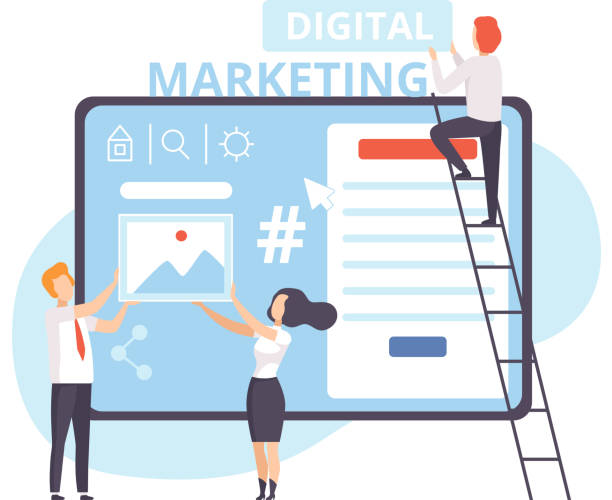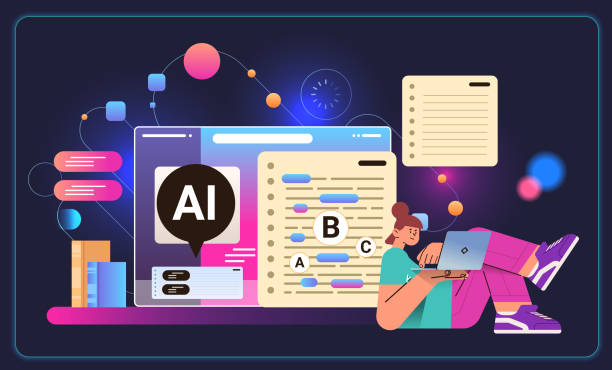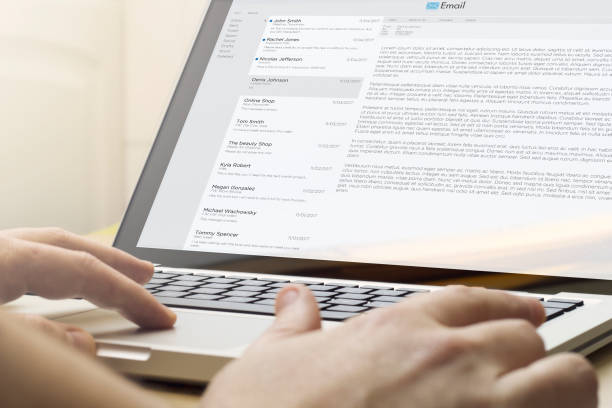The Importance of Fast Website Design in Today’s Digital World

In the age of information and communication, where every second is vitally important, fast website design is no longer a luxury option, but an undeniable necessity.
Did you know that internet users, on average, only wait a few seconds for a website to load? If your site doesn’t load within this short time, the user will likely leave the page and go to your competitors.
This is where the importance of #website_speed becomes apparent.
Website speed not only directly impacts #user_experience, but it is also one of the key factors in #SEO ranking for search engines like Google.
A slow website has a high bounce rate and gradually loses its visitors and potential customers.
The challenging question is, how can we design a site in this intense competition that is both beautiful and loads in a fraction of a second? Is optimizing images alone enough, or are there more complex factors at play? Loading speed is directly tied to the success of online businesses.
A fast website can attract more traffic, have a higher conversion rate, and ultimately increase your revenue.
This clear explanation of why speed is important is an introduction to the more specialized topics we will discuss next.
In this comprehensive article, we will cover all dimensions of this important topic, from technical techniques to practical tools, so that you can optimally begin optimizing your website’s speed and benefit from its countless advantages.
Are you ready to turn your website into a rocket?
Tired of losing business opportunities due to not having a professional corporate website? Worry no more! With RasaWeb’s corporate website design services:
✅ Your brand’s credibility and professionalism will increase.
✅ You will attract more customers and sales leads.
⚡ Get a free consultation right now to get started!
Key Factors Affecting Website Loading Speed

To achieve the goal of fast website design, it is essential to understand the factors affecting website loading speed.
These factors include a wide range of technical considerations, each of which can have a significant impact on the overall performance of the site.
The first and most important factor is #hosting.
The type of hosting (shared, dedicated, cloud), server location, and the quality of its infrastructure all play a key role in the initial speed of the site.
A powerful host close to your target audience can significantly reduce server response time.
The second factor is #optimized_coding.
HTML, CSS, and JavaScript codes should be written in a clean and minimalistic way.
Removing blank spaces, comments, and unnecessary code (Minification) can reduce file sizes and increase browser processing speed.
Using lightweight frameworks and JavaScript libraries that only load necessary modules is also important in this regard.
Also, #image_compression and other multimedia files, without noticeable loss of quality, is another factor that is often overlooked but has a tremendous impact on loading speed.
High-volume images can account for a significant portion of a page’s loading time.
These educational and specialized items are the basis for any speed optimization and must be carefully reviewed so that your site can perform at its best.
Choosing the Right Hosting and the Role of CDN in Speed Increase

The essential step towards fast website design is choosing a #fast_host that is reliable.
There are different types of web hosting services, each with its own advantages and disadvantages in terms of speed and cost.
Shared hosting is cheaper but its resources are divided among several websites, which can lead to slower speeds during peak hours.
In contrast, dedicated or VPS (Virtual Private Server) hosting offers more resources and is more suitable for high-traffic websites.
Cloud hosting, by distributing the load across multiple servers, offers high scalability and stability and can be an ideal option for speed.
Another crucial technology for increasing speed is the use of a #Content_Delivery_Network (CDN).
A CDN is a collection of servers in different geographic locations around the world that store your website’s static content (such as images, CSS, and JavaScript) and deliver it from the server closest to the end user.
This significantly reduces latency and dramatically increases loading speed, especially for users accessing your website from further away.
CDNs also help reduce the load on your main server by providing advanced #caching capabilities.
This specialized guidance shows that investing in quality hosting and a CDN not only increases your site’s speed but also improves user experience and forms one of the most important pillars of fast website design.
In the table below, you can see a comparison of hosting types:
| Hosting Type | Advantages for Speed | Disadvantages | Suitable for |
|---|---|---|---|
| Shared Hosting | Cheap, easy setup | Limited resources, variable speed | Small and startup sites |
| VPS (Virtual Private Server) | More dedicated resources, high flexibility | Requires more technical knowledge, more expensive than shared | Medium-sized sites with growing traffic |
| Dedicated Hosting | Maximum speed and control, high security | Very expensive, requires specialized management | Large, high-traffic corporate websites |
| Cloud Hosting | Excellent scalability, high stability, load distribution | More complexity, variable cost | Sites with fluctuating traffic and high stability needs |
Image and Media Optimization Techniques for Speed

One of the biggest obstacles to fast website design is the large size of images and multimedia files.
These files can account for a significant portion of the page loading time.
Fortunately, by using appropriate #image_optimization techniques, their size can be drastically reduced without a noticeable drop in visual quality.
The first step is image compression.
Many online and offline tools are available for this purpose that can reduce image sizes by up to 70% or even more.
The next step is choosing the right #image_format.
New formats like WebP have smaller sizes than JPEG and PNG while offering acceptable quality.
Using these formats can significantly increase loading speed.
Also, setting the correct dimensions for images before uploading is of great importance.
Loading a large image and then resizing it with CSS only wastes bandwidth and reduces speed.
Another technique is #lazy_loading.
With this method, images and videos are only loaded when the user scrolls to the relevant section on the page, not from the very beginning.
This significantly reduces the initial page loading time.
Optimizing media files is a vital part of the educational process and overall website speed improvement and can greatly enhance your user experience and contribute to fast website design.
Does your current website turn visitors into customers or drive them away? Solve this problem forever with professional corporate website design by RasaWeb!
✅ Build credibility and powerful branding
✅ Attract target customers and increase sales
⚡ Get a free consultation right now!
Optimizing HTML, CSS, and JavaScript Code

In addition to images, website codes also have a great impact on loading speed, and in the process of fast website design, their optimization is of particular importance.
The first step in this area is #Minification or code minimization.
This process involves removing extra white spaces, comments, and unnecessary characters from HTML, CSS, and JavaScript files.
By doing this, file sizes are reduced, and their download and processing speed by the browser increase.
Many tools and plugins are available to automate this process that can help you.
For #optimized_CSS, it is recommended to place CSS files in the
section of the HTML document so that the browser can load them quickly and prevent content rendering issues.Also, avoid frequent use of inline CSS codes, as this increases HTML size and reduces caching capability.
Regarding JavaScript, loading these files can block the page rendering process.
To solve this problem, use the
defer or async attributes for scripts.With
defer, scripts are loaded in the background and only execute after the HTML has finished loading.With
async, scripts are loaded and executed asynchronously.These specialized guidelines in code optimization are fundamental for having a website with excellent performance and significantly contribute to achieving the goal of fast website design.
The Importance of Caching and GZIP Compression

To achieve fast website design and provide an unparalleled user experience, #caching and #GZIP_compression techniques are of high importance.
Caching means temporarily storing data so that on subsequent user visits, there is no need to reload from the server.
This process can be done both on the user’s browser side (browser cache) and on the server side (server caching).
#browser_cache allows the user’s browser to store static files such as images, CSS, and JavaScript in its local memory for a specified period.
This significantly speeds up page loading on subsequent visits to the same site, as many files are already available.
On the server side, caching systems can store database responses or complete HTML pages so that subsequent similar requests do not need to be reprocessed, which is particularly useful for dynamic websites with a lot of content.
#GZIP compression is also a powerful technology for reducing file sizes before sending them to the browser.
This process compresses text files such as HTML, CSS, and JavaScript, reducing bandwidth consumption and consequently increasing data transfer speed and page loading.
Almost all modern servers support GZIP, and activating it will have a significant impact on your website’s speed.
These explanations show how these two techniques can effectively help improve website speed.
Responsive Design and AMP for Mobile Speed

Given the increasing use of mobile devices to access the internet, #Responsive_Design (Responsive Design) and Accelerated Mobile Pages (AMP) play a crucial role in achieving fast website design.
Responsive design means designing a website whose appearance and functionality automatically adjust to the screen size of the user’s device (mobile, tablet, desktop).
This approach not only improves user experience, but Google also recommends it as the best method for mobile-friendly websites.
Responsive sites usually do not require a separate mobile version, which simplifies their management and optimization.
AMP is an open-source framework developed by Google and others to facilitate the creation of fast, high-performance web pages for mobile devices.
AMP pages, using restricted and optimized HTML, CSS, and JavaScript, offer nearly instant loading.
News content and articles often use AMP for fast delivery to mobile users.
This technology is particularly useful for websites with a lot of content that require very high loading speeds on mobile.
The good news is that implementing AMP can also positively impact your site’s SEO ranking in mobile searches.
This is a specialized and evolving topic that is vital for any website looking to optimize for mobile.
Below, you will see a comparison between these two approaches:
| Feature | Responsive Design | AMP (Accelerated Mobile Pages) |
|---|---|---|
| Main Goal | Compatibility with different screen sizes | Very high loading speed on mobile |
| How it works | CSS Media Queries and Flexible Layouts | Restricted and optimized HTML, CSS, JS |
| Need for a separate version | No, one version for all devices | Yes, a separate version for AMP |
| Implementation Complexity | Medium | High (technical limitations) |
| Impact on SEO | Official Google recommendation, ranking factor | Helps appear in special results (Top Stories Carousel) |
Website Speed Analysis and Measurement Tools

After applying various techniques for fast website design, the next stage is precise measurement and analysis of website performance.
Fortunately, powerful tools are available for this purpose that can help you identify the site’s strengths and weaknesses.
One of the most famous and widely used of these tools is #Google_PageSpeed_Insights.
This Google tool provides a score from 0 to 100 for your website’s speed on both mobile and desktop versions and offers suggestions for performance improvement.
These suggestions include image optimization, code minification, cache activation, and more.
Another tool, #GTmetrix, provides very comprehensive and analytical information about your website’s loading speed.
This tool supports Google’s Core Web Vitals and provides detailed information about loading time, page size, number of requests, and the loading sequence of elements.
Also, #Lighthouse, an open-source automated tool for improving web page quality, is provided by Google Chrome and can be run directly from within the browser or as a developer extension.
Lighthouse not only evaluates speed but also measures SEO performance, accessibility, and best development practices.
These guidance and analytical tools help you continuously monitor and improve your site’s speed and ensure that your efforts towards fast website design are fruitful.
Are you falling behind in the competition with large online stores?
RasaWeb, with professional e-commerce website design, will bring your business online and increase your market share!
✅ Increase brand credibility and customer trust
✅ Easy shopping experience leading to more sales
⚡ Take action now for a free website design consultation!
The Impact of Site Speed on SEO and User Experience

Efforts for fast website design are not just about user satisfaction; they have a profound impact on #SEO (Search Engine Optimization) and, consequently, your website’s visibility.
Google has officially announced that page loading speed is a ranking factor.
This has become even more important after Google introduced #Core_Web_Vitals.
Core Web Vitals is a set of user experience metrics that include Largest Contentful Paint (LCP – time to load the largest content), First Input Delay (FID – delay of the first user input), and Cumulative Layout Shift (CLS – cumulative layout shift).
Improving these metrics directly helps improve your site’s SEO ranking.
In addition to SEO, site speed has a direct impact on #user_experience (UX).
A slow site increases the #Bounce_Rate, meaning users quickly leave your site.
In contrast, a fast site encourages users to spend more time on the site, view more pages, and interact with your content.
This improvement in user experience, in turn, leads to an increase in the #Conversion_Rate; meaning more users take your desired action (such as purchasing a product, subscribing to a newsletter, or filling out a contact form).
This analysis shows that speed optimization is not just a technical advantage, but also a powerful marketing strategy that directly impacts the success of your online business.
The Future of Fast Website Design and Emerging Trends

The world of the web is constantly evolving, and with it, the techniques and technologies required for fast website design are also advancing.
In the coming years, we will witness the emergence and expansion of new trends that will increasingly affect website speed and performance.
One of the most important of these trends is #Progressive_Web_Apps (PWA).
PWAs combine the best features of web and native applications; they are fast, reliable, and engaging, and can even work offline, providing a user experience similar to mobile applications.
Another technology on the horizon is #HTTP_3.
This new data transfer protocol, built on QUIC, promises faster and more reliable connections, especially on unstable mobile networks.
With widespread adoption of HTTP/3, web page loading speeds are generally expected to improve.
Also, more advanced approaches to website rendering such as #Server_Side_Rendering (SSR) and Static Site Generation (SSG) will continue to gain popularity, as they help deliver content quickly to the user and optimize the initial loading experience.
These exciting developments show that the boundaries of speed on the web are constantly shifting, and developers and website owners must always stay informed of the latest developments to leverage these advantages for fast and competitive website design and to keep their users engaged and satisfied.
The future of the web will undoubtedly be faster and more efficient.
Frequently Asked Questions
| Question | Answer |
|---|---|
| What is fast website design? | It refers to the process of building a website with high loading speed and optimized for excellent performance. |
| Why is site speed important? | Site speed directly impacts user experience, conversion rate, SEO, and search engine rankings. |
| What are the factors affecting site speed? | Image size, optimized coding, use of CDN, caching, choosing suitable hosting, and the number of plugins. |
| How can I increase website loading speed? | Image optimization, file compression (CSS, JS, HTML), using browser cache, reducing redirects, and using CDN. |
| What is CDN and how does it help site speed? | Content Delivery Network that stores your site’s content on various geographical servers and delivers it from the closest server to the user. |
| What is the role of hosting in site speed? | The quality and type of hosting (shared, VPS, dedicated) greatly affect server response time and consequently, site loading speed. |
| Does using too many plugins reduce site speed? | Yes, each plugin loads additional code which can lead to a slow site. Choosing optimized and essential plugins is recommended. |
| How to optimize images to increase site speed? | Compressing images without quality loss, using modern formats (WebP), setting correct dimensions, and Lazy Loading. |
| How does Caching help site speed? | Caching helps temporarily store site content in the user’s browser or server so that on subsequent visits, the site loads faster. |
| What are the best tools for checking site speed? | Google PageSpeed Insights, GTmetrix, and Pingdom Tools are among the common and useful tools for analyzing and improving site speed. |
And other services of RasaWeb advertising agency in the field of advertising
Smart Sales Automation: A combination of creativity and technology for campaign management through attractive UI design.
Smart Direct Marketing: Transform user engagement with the help of SEO-driven content strategy.
Smart Digital Branding: An effective tool for digital branding with the help of intelligent data analysis.
Smart Sales Automation: A creative platform to improve website traffic by managing Google ads.
Smart Brand Identity: A combination of creativity and technology to increase sales through attractive UI design.
And over hundreds of other services in the field of internet advertising, advertising consultation, and organizational solutions
Internet Advertising | Advertising Strategy | Sponsored Articles
Resources
Fast Website Design Training
WordPress Site Optimization
Website Speed Increase Solutions
How to Have an Optimized Website?
? For your business to soar in the digital world, RasaWeb Digital Marketing Agency is your smart companion. With us, you will have a complete experience of professional services such as website design with a modern user interface to comprehensive SEO and content marketing strategies.
📍 Tehran, Mirdamad Street, next to Central Bank, Southern Kazeroun Alley, Ramin Alley, No. 6




